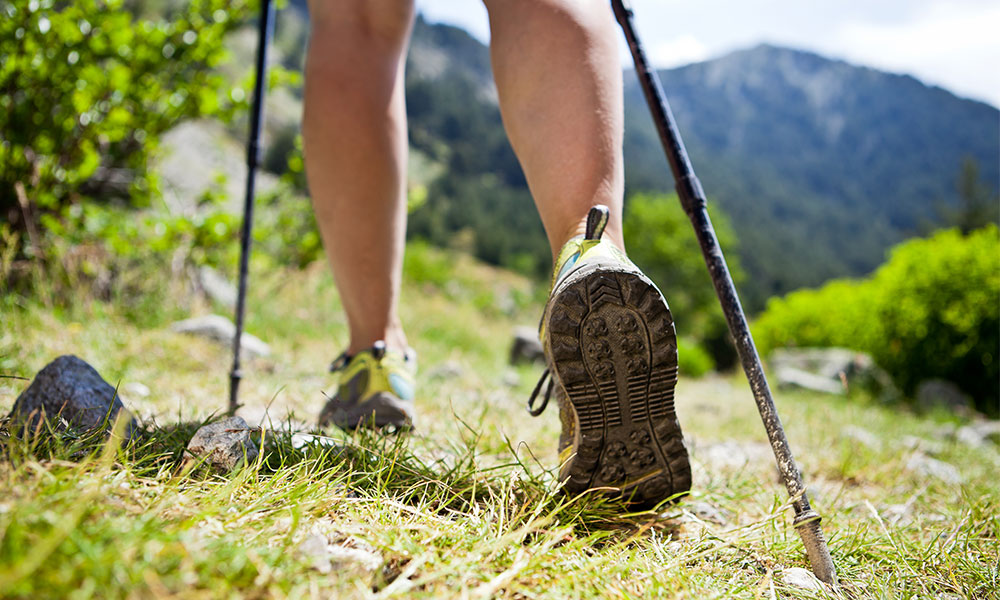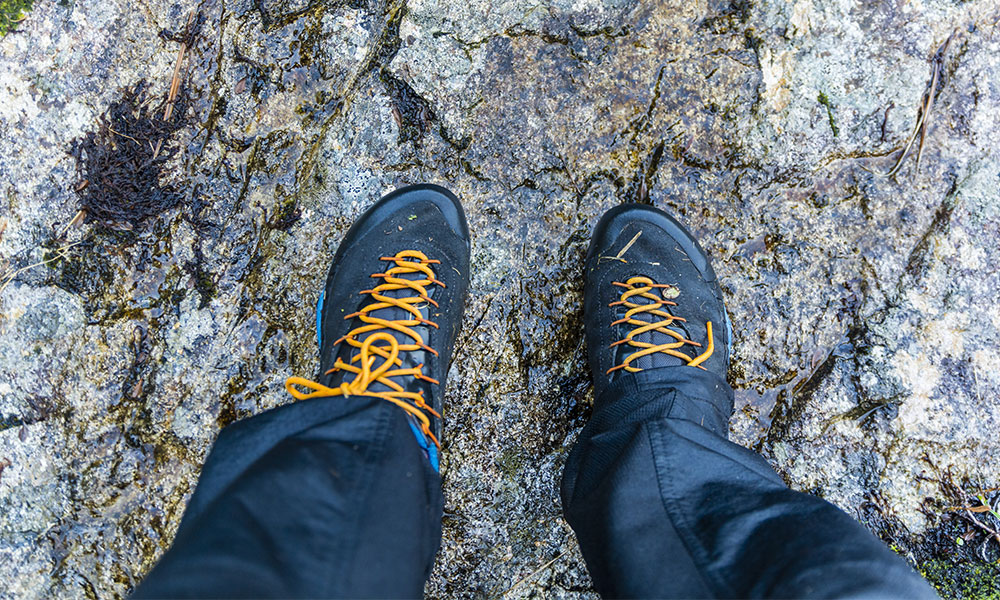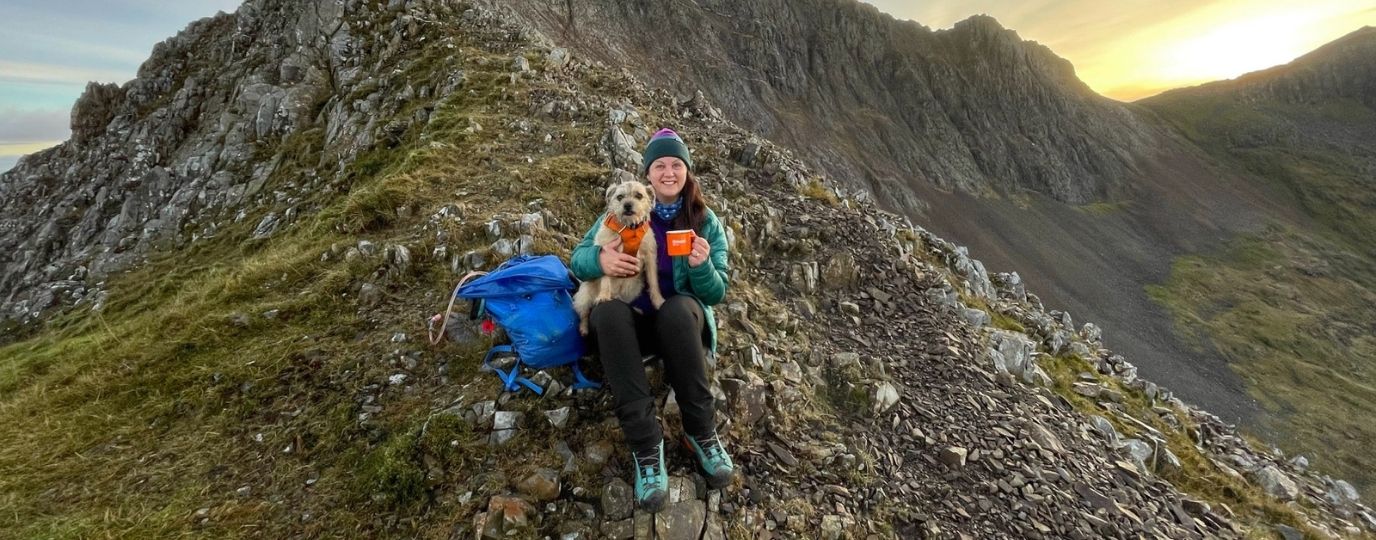Walking and hiking shoes
Regardless of whether you’re a local dog walker or a seasoned trail blazer, you’re going to want to have the right footwear to make your walk more comfortable. We take a detailed look at the best footwear for walking and how they fair across different terrains.
First things first, you’ll need to think about where you’re going and the type of walk you’ll be doing. For example, tackling technical trails or moving fast and light will be far easier with a specific type of footwear. You’ll benefit from having different footwear for a walk in the mountains to a walk in the park. Let’s start by taking a look at some of the most popular types of walking footwear, followed by the more specific……

My chosen footwear for a costal day walk
Walking boots
Sturdy leather walking boots do a great job at keeping your feet dry on wet and muddy walks. They are no good if you want to travel fast and light, but they will give you the greatest level of support and protection, especially over tricky terrain. If you’re prone to twisting your ankles, you may feel more confident in boots. Boots are especially suited to heavy pack loads, providing more stability, so if you struggle to keep pack weight down to a minimum, boots may be for you.
Consider trying ½ a size bigger if planning longer walks or you intend to wear thick socks. If you are using leather boots, make sure they are regularly re-proofed and polished to maintain their waterproofing, and dry them slowly to prevent the leather from cracking. With proper care leather boots can be almost entirely waterproof and last for years.

Leather hiking boots
Like leather, fabric boots with a waterproof membrane such as GORE-TEX® will keep your feet warm and dry in cooler conditions. Many newer-style fabric walking boots have a GORE-TEX® layer and are much lighter than traditional leather boots, offering support without the weight. Fabric boots need less care but do need occasional cleaning and may need re-proofing – follow the manufacturer’s instructions carefully as you may reduce the breathability by using unsuitable cleaning products.
Trail running shoes
The technology in trail shoes has dramatically increased in recent years and many will argue that trail running shoes are just as good as walking boots for long days on the trail, especially in summer. This is mainly due to comfort and breathability. Trail running shoes are much lighter, making it easier to walk as you won’t have as much weight to lift. They also provide more arch support to walking boots or shoes. As well as a grippy sole, many technical trail shoes boast a rock plate, extensive mid-sole cushioning, and toe protection to ensure you’re prepared for any adventure. Like boots, they come in GORE-TEX® versions that offer a good level of waterproofing.

Lightweight trail shoes
Historically, it’s not been recommended to wear trail shoes with a heavy backpack but there has been much debate in recent years. Most hikers on multi-day trips now opt for trail shoes instead of boots, especially as equipment has got lighter over the years and many people now see the benefit of lightweight or ultralight backpacking. Trail shoes are great in summer months or on routes where getting wet feet is inevitable (which means you’ll want quick-drying, breathable shoes). However, it really is down to personal preference.
Walking shoes
Walking shoes sit somewhere between walking boots and trail shoes. They can offer more support and protection than trail shoes but are generally lighter and more flexible and versatile than walking boots. Again, most models are likely to come in a GORE-TEX®/waterproof version. If you’re a boot lover, then a pair of walking shoes may be your footwear of choice in the summer months.

Waterproof walking shoes
Waterproof vs non-waterproof?
Non-leather shoes and boots often come in a waterproof version which has a special membrane to keep your feet dry. The most common is called GORE-TEX®. Waterproof footwear are great at keeping you dry, especially if you’re marching through puddles. However, if your waterproof shoes/boots do get wet, they will take a lot longer to dry than those made from a more breathable material. You may want to consider this if you’re heading off on a multi-day hike where you may not have a chance to dry your shoes out before the next day. Waterproof footwear is also less breathable so your feet may sweat in warmer conditions, making you damp from the inside! If you really hate getting your feet wet but like the idea of fast-drying trail shoes, consider waterproof socks. Popular brands like Sealskinz do a good job at keeping feet dry but they will add weight to your pack. Also consider gaiters which will prevent water and debris from entering your shoe, especially useful in rain.
Walking sandals
Walking sandals are great for the summer and offer good protection underfoot with a sturdier sole to casual sandals. Most also protect your toes but still allow your feet to breathe. If you’re hiking in summer on a route that involves multiple river crossings, then walking sandals will save you the hassle of having to take your shoes and socks on and off each time – with sandals you can simple glide right through! Sandals are popular with long distance hikers who like the carry an extra pair of shoes as a backup.

Walking sandals
Approach shoes
Approach shoes are popular with rock climbers as they are
great for technical rocky terrain. They sit somewhere between walking shoes and
climbing shoes. As the name suggests, they are designed to be worn on the
approach to a climb. They have a thick sole which has good traction on all
types of rock. Whether you’re scrambling or heading to the pub after a climb,
approach shoes will cover both.

Approach shoes
Mountaineering boots
If you’re heading up into the mountains where there’s likely to be snow and ice then a specialist mountaineering boot is needed. They are much stiffer and sit higher up than walking boots as they are designed for the use of crampons. They offer a lot of support and insulation but are only suitable if you’re going to be walking across this type of terrain. They’ll be a deadweight for a leisurely countryside stroll. These are, of course, fully waterproof in order to protect you from snow.

Heavy-duty mountaineering boots
Minimalist shoes
There’s much discussion around minimalist or barefoot-style shoes and many who have given them a go, have continued. These shoes are designed to encourage natural movement and are said to help with injuries by strengthen your foot muscles. They’re not for everyone though and they’ll need a bit of getting used to as it will completely change your walking and running style.

Minimalist shoes
Trainers
The best thing about the great outdoors is that it’s free and stepping outside for some fresh air doesn’t always require any equipment. Now, we don’t recommend you go hiking in your stilettos, but a short walk on a well-trodden path can be done in most types of shoes. Most people have pair of trainers, or a flat-soled shoe that’s comfortable, which should be sufficient for a leisurely stroll. And there’s always your wellies – perfect for wet and muddy pub walks!

Trusty everyday trainers
The all-important fit
Whatever footwear you’re drawn towards, the most important thing to consider is fit. The type of footwear and its features ultimately comes down to personal preference but the number one must is that it fits. You don’t want to be cutting a beautiful outing short just because your shoes have given you blisters.
Try your outdoor footwear on before you buy. Many shops offer a free fitting service and will be able to check the fit for you. If you can, visit the store in the afternoon when your feet may be slightly larger having been on your feet all day. This will give provide a realistic idea of how the shoes will feel after a couple of hours on the trail. Try the footwear on with the socks you’ll be wearing them with as the thickness of the socks will have an impact on fit and comfort. Finally, wear them around the house for a day or two before taking them on out on a real adventure. You’ll want to make sure they are comfortable.
So, now it’s time to tie your laces and step outside in your chosen walking footwear. A decent pair of shoes or boots will be your best companion.





